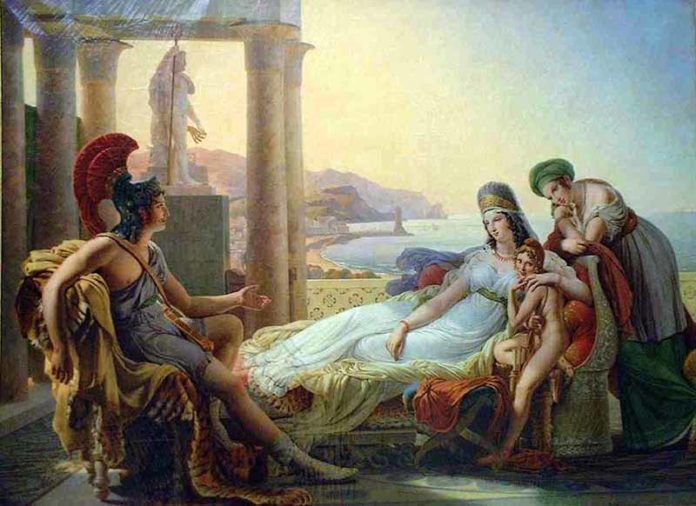
Immortalised by Virgil as the spurned lover of his hero Aeneas, the original story of Dido was very different. Its alteration is symbolic of how the mythology of one culture can be adapted to suit the propaganda of another.
The Punic Myth of Dido
The original myth of Dido is a foundation story. Elissa, sister of Pygmalion, the king of Tyre fled her brother’s kingdom after he murdered her husband. Taking her dead husband’s fortune and a band of followers, she went first to Cyprus before arriving at the coast of Tunisia. Thereafter, Elissa became know as ‘Dido’ meaning ‘the wanderer.’
Declining to join the existing settlers ruled over by the local king, Iarbus, Dido and her people instead wished to found their own city. Iarbus agreed to grant them as much land as could be covered by the hide of a bull. Dido ordered the largest of their bulls to be killed and its hide cut into the thinnest possible strips. In this way, the bull’s hide was stretched all around the hill that became the initial site of the new city. The hill became known as the Byrsa, from the Greek for hide. The city, reputably founded in 814BC was known as Kart Hadasht or ‘new capital’, later known as Carthage.
However, Iarbus was not to be beaten and to gain control of the new city and its imported wealth, he attempted to force Dido to marry him. Realising that a refusal would mean war, Dido agreed. She had a large pyre built for a sacrifice. But the only offering she made was herself when she threw herself into the flames in order to save her city.
Virgil and Dido
Virgil’s version, adopted from the Bellum Poenicum written by Naevius during the late republic, changes Dido from a heroic Queen into an obsessed woman whose thwarted love lies at the root of the enmity between two nations.
In the Roman version, Aeneas, a Trojan survivor and legendary founder the Roman race lands off the coast of Carthage after a storm. Venus leads him to Carthage where he and Dido meet. Dido makes him welcome but also falls in love with him and seduces him in a cave whilst they are hunting. She wishes Aeneas to stay with her. However, it is Aeneas’s mission to establish a new homeland in Italy and he views his liaison with Dido as transitory. Aeneas departs, leaving his lover broken hearted. As in the original myth, Dido casts herself on a pyre. However, her death is not a noble sacrifice but accompanied by a curse on the departing Trojan’s. It establishes a reason why Carthage and Rome were bitter enemies and lays the blame at the feet of a bitter, irrational Carthaginian woman.
Alteration of myth for propaganda purposes
Dido and Aeneas could never have met as the destruction of Troy occurred four centuries after the traditional foundation date of Carthage. However, their association and the change in the character of Dido were necessary to justify Roman aggression towards Carthage. The revamped myth demonstrated that Rome had only defended herself from Carthage’s hatred, therefore making the Punic Wars a matter of national survival rather than a means of taking out a rival.
Sources:
- Tunisia by Michael Tomkinson.
- The Oxford Dictionary of Classical Myth & Religion edited by Simon price and Emily Kearns. Oxford University Press.







